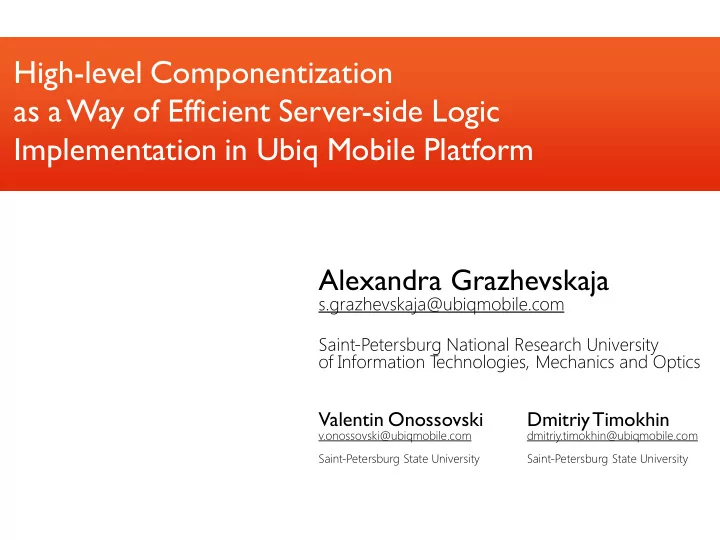

High-level Componentization as a Way of Efficient Server-side Logic Implementation in Ubiq Mobile Platform Alexandra Grazhevskaja s.grazhevskaja@ubiqmobile.com Saint-Petersburg National Research University of Information T echnologies, Mechanics and Optics Valentin Onossovski Dmitriy Timokhin v.onossovski@ubiqmobile.com dmitriy.timokhin@ubiqmobile.com Saint-Petersburg State University Saint-Petersburg State University
Mobilization of business applications MBaaS emergence Problems in business applications’ mobilization. • The importance of easy-to-develop backend and its mobile access. Emergence of MBaaS (StackMob, FeedHenry, AppEngine, • etc.). Insufficient abstraction level of MBaaS systems’ • functionality.
Modern mobile application • Simple application. • Average complexity application. • Distributed mobile application for business: Full variety of platforms, devices and screen resolutions support Versioned and customizable applications High reliability and fault tolerance
Application constructors-based approach • Simple UI - “ready to wear” components. • Simple business logic - “screen flow” transitions description. Conclusion: Development and deployment of simple applications. Business applications - fast prototyping only .
Existing MBaaS tools-based approach Client-side – standard developments tools. Server-side backend - MBaaS systems. • Third-party UI libraries. • Low-level business problems – MBaaS systems. Conclusion: Simple and average complexity applications. Business logic complexity is limited by MBaaS functions abstraction level.
Enterprise level solution and web services-based approach Business logic backend - enterprise-level solution. Connection protocol – web services. • UI – Web technologies. • Business logic – any abstraction level. • Externals easy integration. Conclusion: Connection protocol is limited. Resulting applications are too “heavy”. No content generation and server-side event management. Web UI is inefficient and poor .
Our proposal - “High level integration” approach Business logic backend – server components: • Big, universal, highly integrated, customizable. • Any abstraction level. • “Building blocks” encapsulating self -sufficient fragments of business logic.
Our proposal - “High level integration” approach Opportunities of enterprise-level approach + usability of MBaaS. • Complex business logic of any abstraction level. • Server components implement business process items. • Integration of any business verticals. • No unnecessary traffic consumptions. • Creating components “in one click”.
Basic requirements to the “host” environment Platform-level support of relatively big server-side • independently running components. Mechanism of components’ interaction. • As addition - IDE-level support of integrated • components.
Implementation in Ubiq Mobile platform Platform features: Ultra-thin client-based architecture. • Safe disconnections – saving users’ sessions. • Cross-platform deploy. • Applications: custom and services. • Server core: • Communication with mobile devices Applications’ management and interactions Services over server core through API. • Plug-in for Microsoft Visual Studio. •
Implementation in Ubiq Mobile platform Database service Dispatcher service Auth. service Server core
Case study - Dispatcher Component Componentization of users’ interactions : Authentication; • Interactions’ management; • Storing persistence data. • Logical model of users’ interactions: users and dialogs.
Dispatcher-application interaction • One Dispatcher – one application type. • DispatcherAPI object - locally instantiated in application. • API methods wrap messaging to Dispatcher. • Result – meaningful data or error code.
DispatcherAPI DispatcherAPI functionality: User authentication and registration; • Obtaining information about users; • Dialogs processing; • Inter-user communications. •
Dispatcher usage
Conclusion • High- level integrated “building block” for server side backend. • Libraries of components – fragments of business processes. • Effectiveness of particular implementation. • Components’ extending directions. • Not Ubiq-Mobile locked.
Thank You for Your attention!
Recommend
More recommend